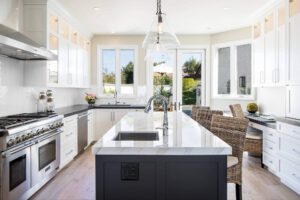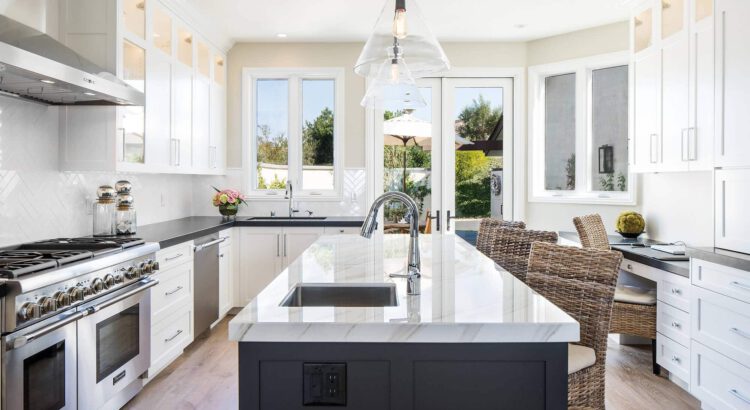A kitchen remodel is a big project that can change your entire home. Goals vary from achieving a new look to adding functionality to an outdated space.
A remodel can involve changing the layout by knocking through walls, removing closets, or installing an island. It can also include replacing or upgrading appliances with more energy-efficient models. To learn more, visit www.kitchenremodelsandiegocal.com/.
A kitchen’s layout is a major contributor to its overall function and design. A well-planned arrangement of cabinets, countertops and appliances is the key to an efficient kitchen. This is why most remodels focus on changing the floorplan. Depending on the scope of this work, it may be necessary to add or remove walls, change electrical wiring and make plumbing changes. For this reason, a kitchen remodel is best left to professionals.
In addition, most mid-size and all major kitchen remodels require a permit, which adds time to the project. If you are considering a full renovation, it’s a good idea to start by setting a budget and finding out how much it will cost for the work you want done. It’s also a good idea to consult with a professional kitchen remodeler about your goals for the space and what can be achieved within your budget.
Before you can begin the actual work, it’s a good idea to get inspired by browsing Pinterest boards and home improvement websites. This will help you narrow down your ideas and show them to the designers and contractors working on your kitchen remodel project.
A u-shaped layout is ideal for large kitchens, as it provides storage and workspace on three walls. In a small kitchen, an L-shaped layout allows for the same functionality, but with a limited footprint. An island can be installed in an L-shaped kitchen to create a more open space, while maintaining the work triangle. Another popular kitchen layout is the g-shaped style, which combines an L-shaped kitchen with a partial fourth wall. This is a great option for homeowners who need to separate the kitchen from the rest of the house, but don’t have the space for a more open concept.
Cabinets
Cabinets are the largest kitchen expense, taking up 15%-35% of your budget. Stock cabinets cost less than custom options, which can be made to order with a variety of features. When choosing your cabinetry, look for quality over style. White melamine-coated particle board drawer boxes and flat panel doors indicate cheap quality, while veneered plywood, hardwood frames and solid wood dovetail joinery are durable and expensive.
Color, finish and hardware can also impact the appearance of cabinets. For example, dark cherry cabinets can make a dramatic statement while light maple is a neutral option. The rise of textured finishes also brings the wood grain to the forefront for an organic look.
Depending on your objectives, the scope of your remodel may range from a simple cosmetic refresh to what MyHome design director Ariana Lovato calls a “total gut” that requires knocking down walls and reconfiguring your floorplan (permits are often required for this work). Once you have decided on the scope of your project, it is time to purchase products.
Cabinet selection is the first step, and you will want to have enough space in a garage or other dry area to store each cabinet until it is ready for installation. You should also be prepared to purchase flooring, countertops, lighting fixtures and appliances during this phase.
When installing new cabinets, consider incorporating special storage designs to maximize your space. For example, a pie-corner base cabinet pulls out to utilize dead corners; or a rotating shelf keeps frequently used items within reach. These units minimize space wastage and keep your kitchen more organized. MyHome remodeling consultants in New York can help you plan your new cabinetry with an eye for functionality and visual appeal.
Countertops
Countertops are the workhorses of any kitchen and must be able to stand up to plenty of abuse. Beyond their aesthetic appeal, you should consider how each surface will hold up to your lifestyle, and which ones offer the best value for your money.
For example, granite and concrete are heavy materials that require strong support, while laminate is comparatively lighter. Some stone countertops can even be molded into different shapes and inlaid with decorative elements like broken tiles or sea shells to create one-of-a-kind patterns.
While contrasting countertop materials like marble and quartz can add visual interest, many homeowners prefer to go for the cohesive look of an integrated surface. This means matching the color and texture of the countertop to the backsplash, cabinet doors, and drawer fronts. This streamlined approach also saves time since you don’t need to grout, caulk or seal the counters and backsplash.
Another advantage of integrated countertops is that it helps to make your kitchen feel bigger and more spacious. In addition, it makes cleanup easier because stains don’t show up as easily. If you decide to use a textured material like granite, you may need to perform regular maintenance to keep the surface looking new.
When planning your budget, it’s crucial to account for all of the costs of your kitchen remodel. In addition to labor, you’ll need to consider the cost of materials and any additional upgrades like electrical or plumbing work. For many, this makes a home equity line of credit (HELOC) a good option for financing their kitchen renovation. Similar to a personal loan, a HELOC offers a set borrowing limit and flexible repayment schedule based on the equity in your home.
Appliances
Appliances are one of the final touches that complete a kitchen remodel. While they are not as crucial as the layout or cabinetry, they can have a big impact on how the kitchen looks and functions. Choosing the right appliances early in your kitchen remodel allows you to decide where they will be installed and how much space you have available for them. This also gives you time to research appliances that fit your budget and lifestyle.
Appliance options are almost limitless today. From WiFi-enabled refrigerators and stoves to a wine fridge or beverage column, you can find a variety of specialized appliances to meet your needs. There are also more traditional choices, such as a dishwasher drawer or a separate cooktop. Some kitchen remodelers even choose panel-ready appliances, which allow you to have custom panels installed on the front of the appliances for a seamless look that blends in with your cabinets.
Upgrading your kitchen appliances can also increase the energy efficiency of your home. Upgrading your ovens and dishwashers to those stamped with the Energy Star label can reduce energy usage by 20 to 40 percent. New ventilation systems can help eliminate toxic pollutants and cooking smells that can linger in the air.
Adding safety features during a kitchen remodel can also make your home safer for everyone in it. This includes slip-resistant flooring, a fire extinguisher in an easily accessible place and more. You may also want to consider upgrading your electrical system during a kitchen remodel to accommodate any additional appliances you have planned. For example, a larger refrigerator might require more power than your existing system can handle. A professional electrician can help you plan for this change.
Lighting
Changing up the lighting in your kitchen is a big step that can really boost the style of the room. It can also have a significant impact on your home’s energy efficiency.
Before you start shopping, make sure that you have a clear idea of what you want and need from your new kitchen lighting. This is especially important if you’re doing a full remodel where you may be relocating outlets and other electrical work.
Start by determining what you want your new kitchen to look like, which can involve browsing Pinterest boards and other home improvement sites for inspiration. You can also create a vision board to help you narrow down your options. This will be helpful for you, as well as for the professionals who’ll be working on your project.
Once you have your goals in mind, it’s time to move on to the planning stage. This includes deciding what the scope of your remodel will be, which can range from a cosmetic refresh to a total gut. The latter typically requires demolition and a change in layout, and will likely require permits.
This is also the time to consider whether you will stay in your home during the remodel, and if so, what your plan is for meal prep during construction. This might include setting up a temporary kitchen, staying with friends or renting an apartment.
Lastly, decide how much you’re willing to spend on your remodel and what the most critical elements are. This will help you focus your search and avoid the temptation to buy things that aren’t within your budget. It’s a good idea to set aside some money for unexpected expenses, too.
